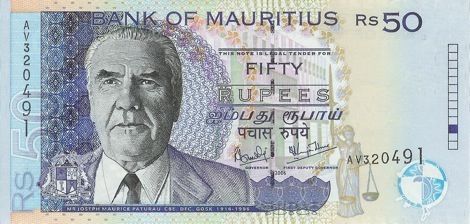Mauritius
Mauritius new 2,000-rupee polymer note (B436a) confirmed
14 12, 2018 08:08 Category: Africa
According to a De La Rue press release dated 6 December 2018, the Bank of Mauritius has introduced a new 2,000-rupee banknote like the preceding paper note, but with upgraded security features, including Safeguard substrate and DLR’s Mask and Illuminate features.
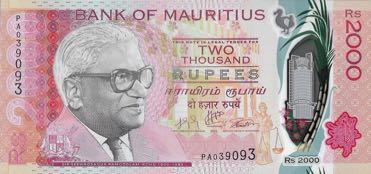
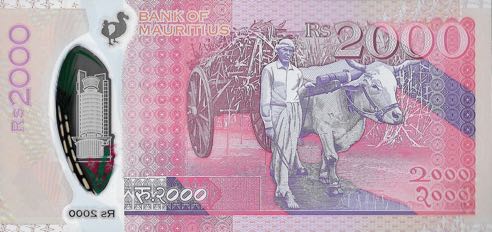
Courtesy of Dennis Zammit and artcoins1983.


Courtesy of Dennis Zammit and artcoins1983.
Mauritius new date (2017) 1,000-rupee note (B429d) confirmed
16 02, 2018 06:30 Category: Africa
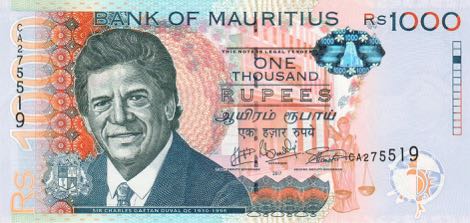
Like B429c, but new date (2017). Prefix CA.
Courtesy of Owen Griffiths.
Mauritius new sig/date (2017) 100-rupee note (B422h) confirmed
16 02, 2018 06:30 Category: Africa
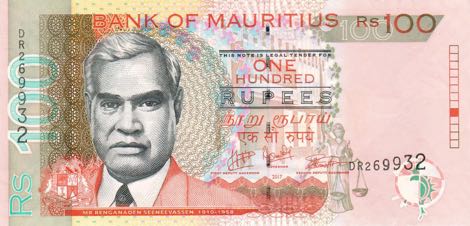
Like B422g, but new signatures and new date (2017). Prefix DR.
Courtesy of Owen Griffiths.
Mauritius new date (2017) 500-rupee note (B432c) confirmed
06 02, 2018 18:12 Category: Africa

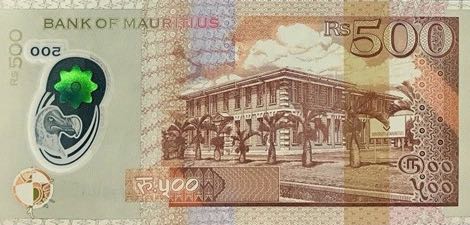
Like B432b, but new date (2017). Prefix PF.
Courtesy of Alex Zlotin.
Mauritius new date (2016) 1,000-rupee note (B429c) confirmed
09 11, 2017 13:20 Category: Africa

Like B429b, but new date (2016). Prefix BP.
Courtesy of Michael Lang.
Mauritius new sig/date (2016) 500-rupee note (B432b) confirmed
07 04, 2017 08:57 Category: Africa
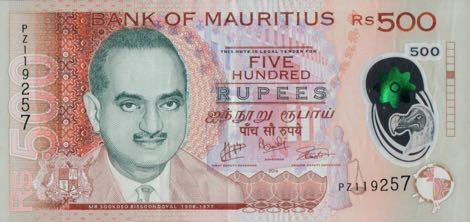
B432b: Like B432a, but new date (2016) and new signatures. Prefix PZ.
Courtesy of Alex Zlotin and Owen Griffiths.
Mauritius new date (2013) 100-rupee note (B422g) confirmed
09 11, 2016 13:54 Category: Africa


B422g: Like B422f, but new date (2013). Prefix CY.
Courtesy of Rex Hilligan.
Mauritius new sig/date (2015) 1,000-rupee note (B429b) confirmed
23 06, 2016 07:18 Category: Africa
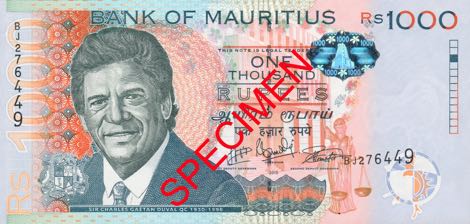
B429b: Like B429a, but new signatures (Yandraduth Googoolye, Rameswurlall Basant Roi, and Mahendra Vikramdass Punchoo) and new date (2015). Prefix BJ.
Courtesy of Owen Griffiths.
Mauritius announces plans to introduce new note family in late 2017
23 06, 2016 07:16 Category: Africa
According to a press release dated 17 June 2016, the Bank of Mauritius has begun planning a new family of banknotes to be issued in a phased manner beginning in the second half of 2017 with improved security features and entirely new designs. The portraits will be replaced with illustrative elements that may include Mauritius’ “national heritage, history, culture, endemic species of the Mauritian flora and fauna, and distinctive landscapes.”
Mauritius new sig/date (2013) 200-rupee note confirmed
29 01, 2014 08:30 Category: Africa

200 rupees, 2013. Like BOM B27, but new date and signatures.
Courtesy of Claudio Marana.
Mauritius new 25- and 50-rupee polymer notes confirmed
21 09, 2013 13:43 Category: Africa
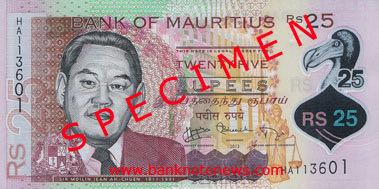

BOM B30 (PNL): 25 rupees (US$0.80)
Violet and brown. Front: Coat of arms; Milin Jean Ah-Chuen; bank building façade; standing Justice with sword and scales; dodo bird. Back: Dodo bird; building façade, Rodrigues island map; man with trap. No security thread. Watermark (shadow image): RS. Printer: (OT). 135 x 65 mm. Polymer.
a. 2013. Signature 9. Intro: 22.08.2013.
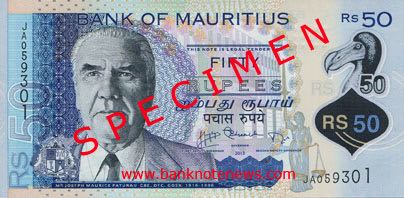
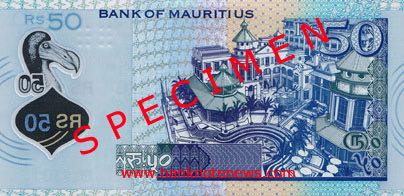
BOM B31 (PNL): 50 rupees (US$1.60)
Blue. Front: Coat of arms; Joseph Maurice Paturau; bank building façade; standing Justice with sword and scales; dodo bird. Back: Dodo bird; Le Caudan waterfront buildings. No security thread. Watermark (shadow image): RS. Printer: (OT). 140 x 68 mm. Polymer.
a. 2013. Signature 9. Intro: 22.08.2013.
According to an official press release, on 22 August 2013, the Bank of Mauritius issued new 25-, 50-, and 500-rupee banknotes printed on polymer. The 25- and 50-rupee notes were printed by Oberthur Technologies on Innovia Security's Guardian substrate, whereas the 500-rupee note was printed on De La Rue’s Safeguard substrate (formerly called Flexycoin). The new polymer notes will circulate in parallel with the preceding paper banknotes upon which their designs are based. The notes contain numerous new security features such as transparent windows showing the image of the dodo, numbers printed with magnetic ink which become fluorescent under ultra violet light, and swing features printed in iridescent ink, which change to a different color when observed in transparency or when tilted.
Courtesy of Hartmut Fraunhoffer (http://www.banknoten.de).
Mauritius new 500-rupee polymer notes confirmed
29 09, 2013 13:52 Category: Africa
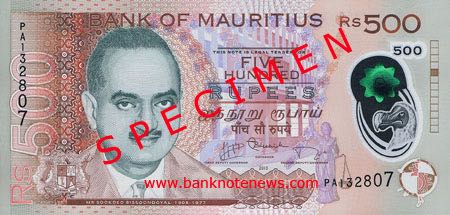

BOM B32 (PNL): 500 rupees (US$16)
Orange. Front: Coat of arms; Sookdeo Bissoondoyal; bank building façade; standing Justice with sword and scales; blue-to-green OVI patch. Back: Blue-to-green OVI patch; University of Mauritius building and palm trees in Reduit. No security thread. Watermark (shadow image): None. Printer: (TDLR). 155 x 74 mm. Polymer.
a. 2013. Signature 9. Intro: 22.08.2013.
According to an official press release, on 22 August 2013, the Bank of Mauritius issued new 25-, 50-, and 500-rupee banknotes printed on polymer. The 25- and 50-rupee notes were printed by Oberthur Technologies on Innovia Security's Guardian substrate, whereas the 500-rupee note was printed on De La Rue’s Safeguard substrate (formerly called Flexycoin). The new polymer notes will circulate in parallel with the preceding paper banknotes upon which their designs are based. The notes contain numerous new security features such as transparent windows showing the image of the dodo, numbers printed with magnetic ink which become fluorescent under ultra violet light, and swing features printed in iridescent ink, which change to a different color when observed in transparency or when tilted.
Courtesy of Mike Jackson, Thomas Krause, Alex Tobert, and Hartmut Fraunhoffer (http://www.banknoten.de).
Mauritius to issue polymer banknotes
26 05, 2013 10:56 Category: Africa
An article on BusinessMega dated 26 May 2013 states that the Bank of Mauritius will soon issue polymer banknotes, according to the Facebook page of Deputy Prime Minister and Finance Minister Xavier-Luc Duval. Polymer will be used for 25-, 50-, and 500-rupee notes "in the coming months" and will circulate in parallel with the existing paper notes of the same denominations.
Courtesy of Thomas Krause (http://www.polymernotes.de).
Courtesy of Thomas Krause (http://www.polymernotes.de).
Mauritius new sig/date (2012) 100-rupee note confirmed
07 02, 2013 08:33 Category: Africa
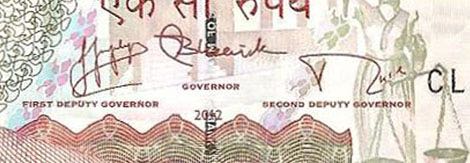
100 rupees, 2012. Like BOM B22 (P56), but new date and new signature for second deputy governor, Mohammed Iqbal Belath.
Courtesy of Owen Griffiths.
Mauritius chapter of The Banknote Book is now complete
01 04, 2016 11:14 Category: The Banknote Book | Africa
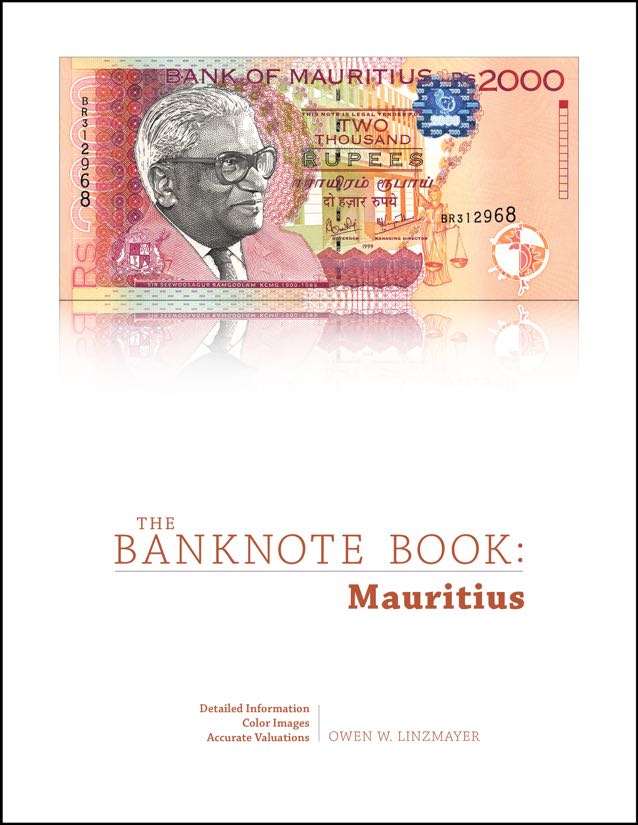
The Mauritius chapter of The Banknote Book is now available for individual sale and as a free download to subscribers.
This 23-page catalog covers notes issued by the Special Finance Committee in 1842, Currency Commissioners of Mauritius from 1848 to 1849, Government of Mauritius from 1860 to 1965, and Bank of Mauritius from 1967 to present. Revised 1 April 2016.
Each chapter of The Banknote Book includes detailed descriptions and background information, full-color images, and accurate valuations. The Banknote Book also features:
- Sharp color images of note’s front and back without overlap
- Face value or date of demonetization if no longer legal tender
- Specific identification of all vignette elements
- Security features described in full
- Printer imprint reproduced exactly as on note
- Each date/signature variety assigned an individual letter
- Variety checkboxes for tracking your collection and want list
- Date reproduced exactly as on note
- Precise date of introduction noted when known
- Replacement note information
- Signature tables, often with names and terms of service
- Background information for historical and cultural context
- Details magnified to distinguish between note varieties
- Bibliographic sources listed for further research
Subscribe to The Banknote Book
If you collect the entire world or a large number of countries, buying a subscription is the best deal because it's less expensive than buying chapters individually, and it entitles you to every chapter currently available as well as everything published—or revised (click here to see the Change Log)—during the term of your subscription.

Sign up for Email Notifications
If you would like to receive email notifications whenever a new chapter of The Banknote Book is published, please join the email list.

Mauritius new 200-, 500-, and 1,000-rupee notes confirmed
15 12, 2011 08:12 Category: Africa


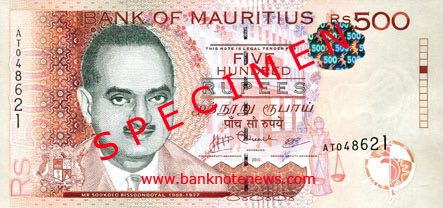
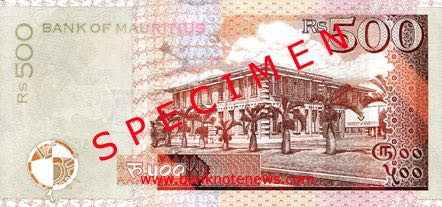
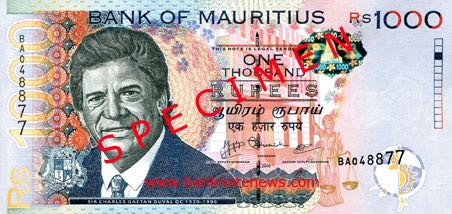
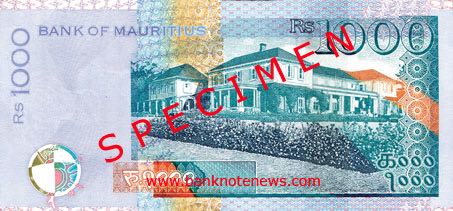
According to a press release dated 10 October 2011, on 14 October Bank of Mauritius issued revised 200-, 500-, and 1,000-rupee (US$6.90, 17.25, and 34.55, respectively) banknotes with new security features:
Multi Image Hologram upgrade for 200- and 500-rupee banknotes
This upgrade consists of a new feature which appears as a Multi Image design of a dodo and the face value as a new feature on the 200-rupee banknote, whereas the previous silver foil on the 500-rupee banknote has been replaced by a Multi Image design of a deer and the value of Rs500.
Depth Image Hologram upgrade for 1,000-rupee banknote
This feature replaces the current silver foil on the 1,000-rupee banknote and is an optically variable device. Classical holography allows a perception of depth by placing an image over a secondary plane apparently deep. On the hologram there is a registered central image of the Bank of Mauritius Tower and in the background the Multi Image feature showing the design of a key and the value of Rs1000.
Courtesy of Sami Kiuru, Claudio Marana, and Noteshobby.
Mauritius new date (2009) 25-, 50-, and 100-rupee notes confirmed
02 09, 2010 22:10 Category: Africa
25 rupees (US$0.80). 2009. Like P49, but new date and new signatures (see below).
50 rupees (US$1.60). 2009. Like P50, but new date and new signatures (see below).

100 rupees (US$3.20). 2009. Like P56, but new date.
Courtesy of banknoteshop@gmx.net and Bill Stubkjaer.
50 rupees (US$1.60). 2009. Like P50, but new date and new signatures (see below).

100 rupees (US$3.20). 2009. Like P56, but new date.
Courtesy of banknoteshop@gmx.net and Bill Stubkjaer.
Mauritius to introduce polymer notes
10 12, 2008 15:05 Category: Africa
According to an African Press Agency report dated 10 December 2008, the Bank of Mauritius plans to introduce polymer banknotes as a cost-cutting measure. The press release from the bank in Port Louis indicates that even though it costs US$0.50 to manufacture a polymer note versus US$0.05 for a paper note, the polymer notes have a lifespan of 20 to 25 years, which makes them more cost-effective in the long term. The Bank of Mauritius will invite tenders for the manufacture of polymer 25-, 50-, and 100-rupee notes in early 2009.
Please note that the above information is based upon the APA report. I have not been able to locate the bank press release which the report cites, and strongly suspect the report is in error. Polymer banknotes certainly do last longer than paper notes, but a 20-25 year lifespan is unheard of (polymer notes haven’t even been around that long). According to Securency, the Australian supplier of polymer substrate, polymer notes can last up to four times longer than paper, which can start to wear out in as little as one year of circulation.
Please note that the above information is based upon the APA report. I have not been able to locate the bank press release which the report cites, and strongly suspect the report is in error. Polymer banknotes certainly do last longer than paper notes, but a 20-25 year lifespan is unheard of (polymer notes haven’t even been around that long). According to Securency, the Australian supplier of polymer substrate, polymer notes can last up to four times longer than paper, which can start to wear out in as little as one year of circulation.
Mauritius new date (2007) 1,000-rupee note confirmed
12 04, 2008 10:07 Category: Africa
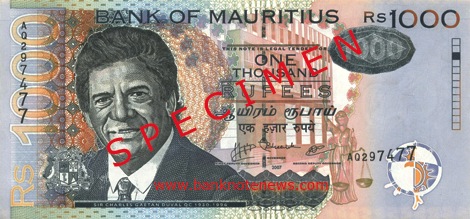
1,000 rupees (US$38.70), 2007. Like P59, but new date and new signatures (Yandraduth Googoolye, FIRST DEPUTY GOVERNOR; Rundheersing Bheenick, GOVERNOR; Ahmad Jameel Khadaroo, SECOND DEPUTY GOVERNOR).
Courtesy of Steve Milner.
Mauritius issues new date (2004) 1,000-rupee note
12 07, 2006 11:08 Category: Africa

1,000 rupees, 2004. New date. Issued July 12, 2006.
Mauritius new date (2006) 1,000-rupee note confirmed
08 02, 2007 18:04 Category: Africa
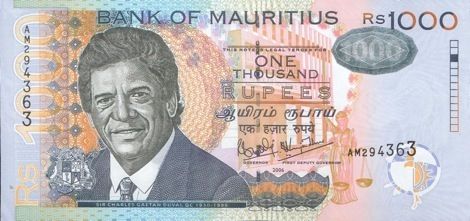
1,000 rupees (US$30.70), 2006. Like Pick 59, but new date.
Courtesy of Paul van Bodegraven.
Mauritius issues new date (2006) 50-rupee note
08 02, 2007 18:00 Category: Africa
Mauritius announces new banknote design contest
25 09, 2007 12:05 Category: Africa
On September 25, 2007, Manou Bheenick, governor of the Bank of Mauritius, announced a design competition for a new family of banknotes to be issued in 2009 to celebrate the bank’s 40th anniversary. Under the theme of “Banknotes—Mirrors of our Motherland,” this eighth series of notes should relate to the islands’ history, culture, ecology, industry, architecture, and landscape. Rs30,000 will be awarded to the winner of the best design as chosen by a jury of eight local artists. The competition is open to Mauritian nationals only, and proposals must be submitted by October 31, 2007.
The bank will also conduct a study on the Mauritian people’s preferences about the patterns to include on these new notes. “The idea is to know what the Mauritian people want to see on the banknotes,” said Bheenick.
The bank will also conduct a study on the Mauritian people’s preferences about the patterns to include on these new notes. “The idea is to know what the Mauritian people want to see on the banknotes,” said Bheenick.
